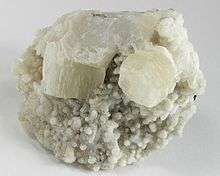Witherite
Witherite is a barium carbonate mineral, BaCO3, in the aragonite group.[1] Witherite crystallizes in the orthorhombic system and virtually always is twinned.[1] The mineral is colorless, milky-white, grey, pale-yellow, green, to pale-brown. The specific gravity is 4.3, which is high for a translucent mineral.[1] It fluoresces light blue under both long- and short-wave UV light, and is phosphorescent under short-wave UV light.[1]
| Witherite | |
|---|---|
 | |
| General | |
| Category | Carbonate mineral |
| Formula (repeating unit) | BaCO3 |
| Strunz classification | 5.AB.15 |
| Crystal system | Orthorhombic |
| Crystal class | Dipyramidal (mmm) H-M symbol: (2/m 2/m 2/m) |
| Space group | Pmcn |
| Unit cell | a = 5.31 Å, b = 8.9 Å c = 6.43 Å; Z = 4 |
| Identification | |
| Color | Colorless, white, pale gray, with possible tints of pale-yellow, pale-brown, or pale-green |
| Crystal habit | Striated short prismatic crystals, also botryoidal to spherical, columnar fibrous, granular, massive. |
| Twinning | On {110}, universal |
| Cleavage | Distinct on {010} poor on {110}, {012} |
| Fracture | Subconchoidal |
| Mohs scale hardness | 3.0 - 3.5 |
| Luster | Vitreous, resinous on fractures |
| Streak | White |
| Diaphaneity | Subtransparent to translucent |
| Specific gravity | 4.3 |
| Optical properties | Biaxial (-) |
| Refractive index | nα = 1.529 nβ = 1.676 nγ = 1.677 |
| Birefringence | δ = 0.148 |
| 2V angle | Measured: 16°, calculated: 8° |
| Dispersion | Weak |
| Ultraviolet fluorescence | Fluorescent and phosphorescent, short UV=bluish white, long UV=bluish white |
| References | [1][2][3][4] |
Witherite forms in low-temperature hydrothermal environments. It is commonly associated with fluorite, celestine, galena, barite, calcite, and aragonite. Witherite occurrences include: Cave-in-Rock, Illinois, US; Pigeon Roost Mine, Glenwood, Arkansas, US; Settlingstones Mine Northumberland; Alston Moor, Cumbria; Anglezarke, Lancashire and Burnhope,[5] County Durham, England; Thunder Bay area, Ontario, Canada, Germany, and Poland (Tarnowskie Góry and Tajno at Suwałki Region).
Witherite was named after William Withering (1741–1799) an English physician and naturalist who in 1784 published his research on the new mineral. He could show that barite and the new mineral were two different minerals.[3][6]
Discovery

In 1789 the eminent German geologist Abraham Gottlob Werner named the mineral witherite in honour of William Withering.[7] The Matthew Boulton mineral collection of Birmingham Museum and Art Gallery may contain one of the earliest known specimens of witherite. A label in Boulton's handwriting, records: "No.2 Terra Ponderosa Aerata, given me by Dr. Withering”.[8]
Risk to human health
The 18th-century naturalist Dr. Leigh recorded its lethal effects after the death of a farmer's wife and child. James Watt Jnr. experimented with the mineral on animals and he recorded the same lethal properties.[9] Until the 18th century farmers at Anglezarke used the mineral as rat poison.[10]
Industrial use
An experiment conducted by Josiah Wedgwood, led to it being used in his 'Jasper ware'; the mineral had previously been considered as worthless.[10] Witherite has been used for hardening steel, and for making cement, glass, enamelware, soap, dye and explosives.[11]
References
- Witherite mindat.org
- Handbook of Mineralogy
- Webmineral data
- Mineralienatlas
- Ashburn, J.H., Mining Witherite in North-West Durham, Colliery Guardian, August 1963 (at Durham Mining Museum web-site)
- Withering, William (1784). "Experiments and Observations on Terra Poderosa". Philosophical Transactions of the Royal Society of London. 74: 293–311. doi:10.1098/rstl.1784.0024.
- "William Withering (1741-1799): a biographical sketch of a Birmingham Lunatic." M R Lee, James Lind Library, accessed 25 September 2006
- Starkey, R. E. (2011). "Matthew Boulton, his mineral collection and the Lunar Men". The Newsletter of the Russell Society. 59: 1–8.
- Watt, James Jr. (1789). Memoirs and Proceedings of the Manchester Philosophical Society. p. 598.
- The Mining Magazine, March 1963, Vol 108, pages 133–139
- 'Looking Back' p10 Hexham Courant 10 January 2014 featuring a photograph of Settlingstones miners in 1905
External links
![]()